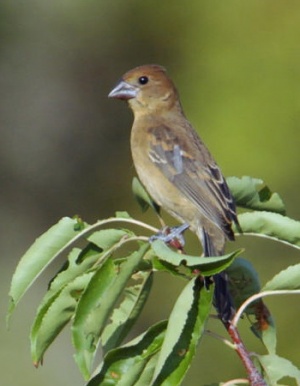- Passerina caerulea
Guiraca caerulea
Identification
L. 6 3/4" (17 cm)
Male:
- Dark blue
- Rusty wing bars
- Large beak
- Black face
Female:
- Buffy brown
- Rusty wing-bars
Immature Similar to female, but 1st winter birds are more rufous.
Similar Species
This large Cardinaline Bunting is often mistaken for an Indigo Bunting, which does not have the rusty 'shoulders' seen as wing bars in flight, or the large beak as indicated by the name: grosbeak.
Distribution
Southern United States north to central California, South Dakota, southern Pennsylvania and southern New Jersey. Casual north of regular range. Winters south to Panama.
Taxonomy
This species has in the past been placed in genus Guiraca
Subspecies
This is a polytypic species[1] consisting of 7 subspecies.
- P. c. salicaria: Grinnell, 1911
- North-central [[California and western Nevada to north-western Baja; winters to Guerrero
- P. c. interfusa: Dwight & Griscom, 1927
- P. c. deltarhyncha: Van Rossem, 1938
- Coastal western Mexico (southern Sinaloa and Durango to Oaxaca)
- P. c. caerulea: Linnaeus, 1758
- P. c. eurhyncha: Coues, 1874
- Eastern Mexico (Coahuila to Nuevo León, southern Tamaulipas and Oaxaca)
- P. c. chiapensis: Nelson, 1898
- P. c. lazula: Lesson, 1842
- Honduras to Nicaragua and Costa Rica
Habitat
Shrubby fields, open habitat with scattered trees, scrub, thickets, cultivated lands, woodland edges, overgrown fields, hedgerows.
Behaviour
Diet
The diet includes insects, snails, spiders, seeds, grains, and fruits. Its large bill can manage large seeds, like corn, and large insects like grasshoppers.
Breeding
The nest is built low in small trees and shrubs. It is a compact cup of bark, rootlets, twigs, and other fibrous material. The clutch consists of 3-5 pale blue eggs; incubation takes 11-12 days, followed by fledging at 9-10 days.
Blue Grosbeak nests are sometimes parasitized by Brown-headed Cowbirds.
References
- Clements, J. F., T. S. Schulenberg, M. J. Iliff, D. Roberson, T. A. Fredericks, B. L. Sullivan, and C. L. Wood. 2016. The eBird/Clements checklist of birds of the world: v2016, with updates to August 2016. Downloaded from http://www.birds.cornell.edu/clementschecklist/download/
- ITIS
Recommended Citation
- BirdForum Opus contributors. (2024) Blue Grosbeak. In: BirdForum, the forum for wild birds and birding. Retrieved 27 July 2024 from https://www.birdforum.net/opus/Blue_Grosbeak
External Links
GSearch checked for 2020 platform.1






